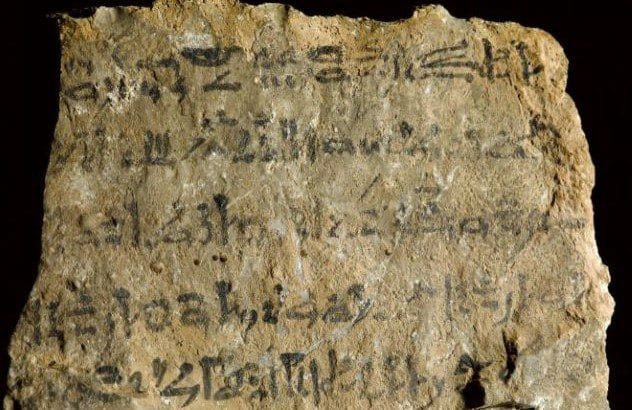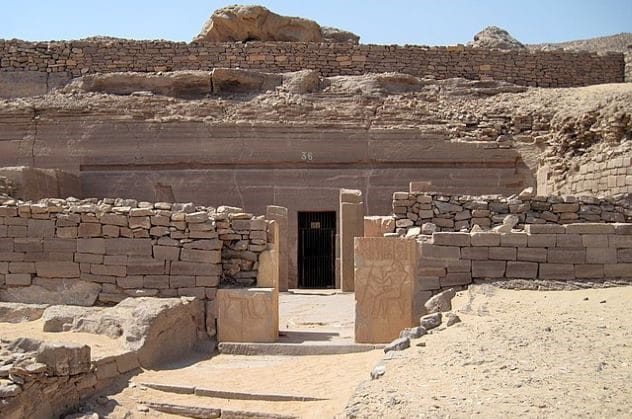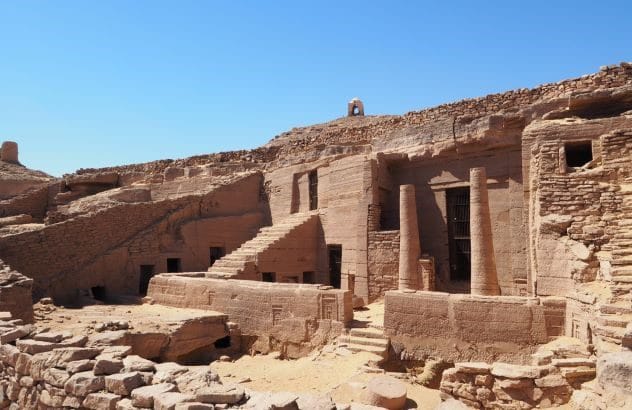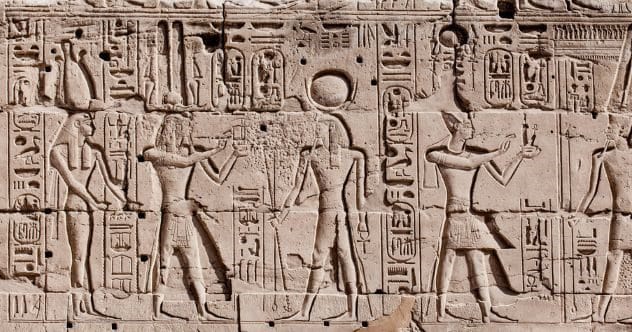The history of Egyptian writing spans over 5,000 years, making it one of the oldest known writing systems in the world. It all began around 3,200 BC with the invention of hieroglyphs, a system of pictorial symbols used by the ancient Egyptians. Hieroglyphs were primarily used for religious and monumental inscriptions and adorned the walls of temples and tombs.
Over time, the Egyptian writing system evolved to include other scripts that were more accessible and practical. Hieroglyphics, until relatively recently, left scientists baffled. The decipherment of Egyptian hieroglyphs was achieved in the early 19th century by the French scholar Jean-François Champollion. Now that we are able to read what hieroglyphics say, we’re starting to uncover some pretty nefarious messages, including curses and warnings. Get ready to explore the eerie side of ancient Egypt as we reveal ten creepy curses hidden in hieroglyphics.
10 The Sheikh Abd el-Qurna Inscription

Sheikh Abd el-Qurna, a necropolis in Thebes (modern-day Luxor), holds numerous tombs with inscriptions meant to deter tomb raiders. One particular slab, now in the National Museum of Scotland, carries a stern warning written in hieratic:
“Watch out not to take a pebble from within it outside. If you find this stone, you shall not transgress against it. Indeed, the gods since the time of Pre, those who rest in the mountains gain strength every day, even though their pebbles are dragged away.”
This inscription warns that removing even a stone from the tomb will incur the wrath of the gods. The irony? The stone itself was removed to Scotland, seemingly without consequence.
9 Amenhotep Tomb Curse
In the Valley of the Kings lies the tomb of Amenhotep, where a terrifying inscription warns trespassers against disturbing the sleeping king. The inscription details a laundry list of punishments for anyone who dares to steal from the tomb, including loss of earthly wealth, drowning at sea, burning to death, and the demise of their lineage. Despite the extensive curse, it doesn’t appear to have deterred modern explorers.
8 The Mastabas at Saqqara
Saqqara features mastabas, flat-roofed tombs containing mummies. Some of these tombs boast colorful hieroglyphics that warn potential looters of divine punishment. One professor noted that these tombs condemn any “impure persons” who enter, promising the gods will wring the intruder’s neck like a goose.
An inscription on the mastaba of Khentika Ikhekhi reads, “As for all men who shall enter this my tomb impure, I shall seize his neck like a bird.”
7 The Execration Texts

Dating back to the 24th to 22nd centuries BC, the execration texts are a collection of curses inscribed on pottery, often in the form of human-like figures. Unlike tomb curses, these were aimed at foreign neighbors or enemies of the state.
Ancient Egyptians would write the names of their enemies, along with a curse, on pottery or stone, then break and bury the pieces near ritual sites or burial grounds. The texts contain phrases like “slaughter him with a knife” or “smite him with a spear,” promising a gruesome end to those named.
6 The Tomb of Ankhtifi
Ankhtifi, a nomarch from around 2100 BC, left a clear warning on his tomb walls. The inscription states that any ruler who harms his coffin will be rejected by Hemen, and the tomb raider’s heirs will lose their inheritance. While it may not deter modern archaeologists, it seems to have worked in ancient times.
5 Sarenput I

Sarenput I, a leader of Elephantine during the 12th dynasty, inscribed his tomb to protect the offerings near a statue of the gods. The inscription details a gruesome fate for anyone who dares to steal the offerings:
“His arm shall be cut off like that of this bull, his neck shall be twisted off like that of a bird… I shall be against him as a crocodile on the water, as a serpent on earth, and as an enemy in the necropolis.”
The curse is a clear warning to think twice before entering the tomb, even for archaeologists.
4 Harkhuf’s Tomb

Harkhuf, an ancient Egyptian explorer during the 6th dynasty, included a warning for anyone disturbing his peace. The inscription reads, “As for any man who shall enter into this tomb, I will seize him like a wild fowl. He shall be judged by the great god.”
In the Age of the Pyramids, being cursed by the Great God was the worst fate imaginable.
3 The Tomb of Ankhmahor
Located in Saqqara, the tomb of Ankhmahor contains a curse to deter tomb raiders. The inscription warns, “As for that which anyone might do against this my tomb, the same will be done to his property… I shall seize him like a goose and fill him with fear at seeing ghosts upon the earth.”
This priest knew magic and wasn’t afraid to use it, making the tomb a place to avoid.
2 The Tomb of Senenmut
Senenmut, a high priest and royal advisor to Queen Hatshepsut, had his tomb constructed near the Queen’s. The tomb contained an inscription that read, “His lifetime shall not exist on earth,” a curse for any trespassers.
Thankfully, this hasn’t stopped modern archaeologists from making key discoveries in the tomb.
1 The Tomb of Hezi
The tomb of Hezi, located in Saqqara, houses the body of a nobleman. The hieroglyphic inscriptions start by describing Hezi’s life before launching into a unique curse: “As for anyone who will enter this tomb after he has eaten abominations or after he has copulated with women; I will be judged with him in the council of the Great God.”
This curse strangely condemns both the trespasser and Hezi himself, adding an eerie twist.
These ancient Egyptian curses offer a glimpse into the beliefs and fears of a long-lost world. Whether protecting tombs or cursing enemies, these inscriptions provide chilling insights into the minds of those who created them.
Which curse did you find the creepiest? Leave your comment below!










